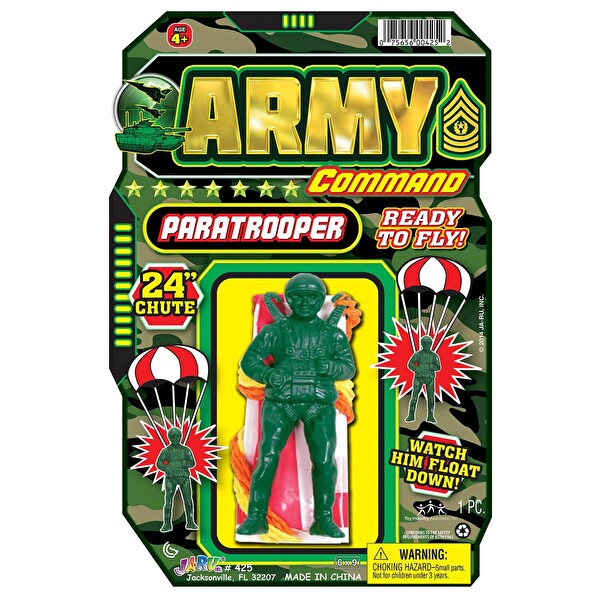Log in
Search
Latest topics
» My N-1R build logby rsv1cox Today at 7:05 am
» Funny what you find when you go looking
by rsv1cox Yesterday at 3:21 pm
» Landing-gear tips
by 1975 control line guy Yesterday at 8:17 am
» Purchased the last of any bult engines from Ken Enya
by sosam117 Yesterday at 7:45 am
» Cox NaBOO - Just in time for Halloween
by rsv1cox Tue Nov 19, 2024 6:35 pm
» Canada Post strike - We are still shipping :)
by Cox International Tue Nov 19, 2024 12:01 pm
» Duende V model from RC Model magazine 1983.
by getback Tue Nov 19, 2024 6:08 am
» My current avatar photo
by roddie Mon Nov 18, 2024 9:05 pm
» My latest doodle...
by TD ABUSER Mon Nov 18, 2024 11:30 am
» Brushless motors?
by rsv1cox Sun Nov 17, 2024 6:40 pm
» Free Flight Radio Assist
by rdw777 Sun Nov 17, 2024 6:03 pm
» Tribute Shoestring build
by amurphy6812 Sun Nov 17, 2024 5:43 pm
Cox Engine of The Month
After 84 years, seven months and 15 days the Wen Mac P-38 is here
Page 1 of 1
 After 84 years, seven months and 15 days the Wen Mac P-38 is here
After 84 years, seven months and 15 days the Wen Mac P-38 is here
Well, maybe not quite that long. My first exposure to the P-38 was in movie theater newsreels during WW2. More like the last ten years when I started chasing these Wen Mac variations. Built my scratch hollow log P-38 some 50 years ago in the early 1970's.
Post Office delivered it today. Little box compared to the unopened Gilbert SkyFlash. Kinda worried, did he take it apart......these don't come apart.

After a mile or so of bubble wrap............somehow I thought it would be bigger.

Eager to check it against my wall hanger but often flown model.
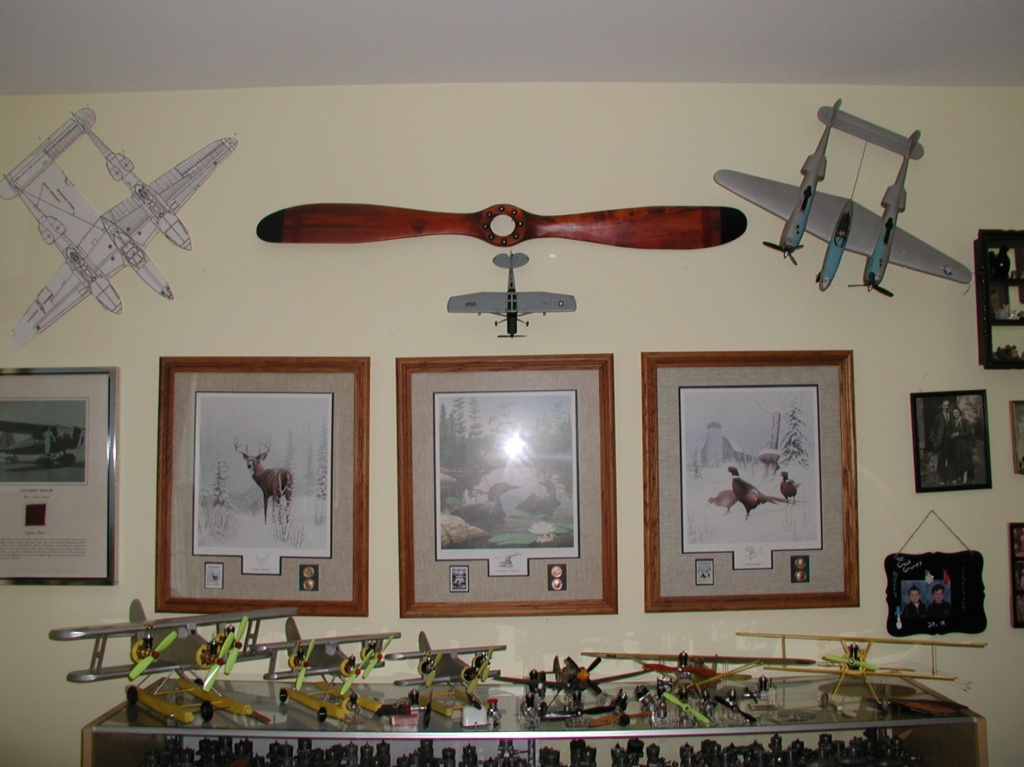
Smaller. "Somehow I thought it would be bigger."
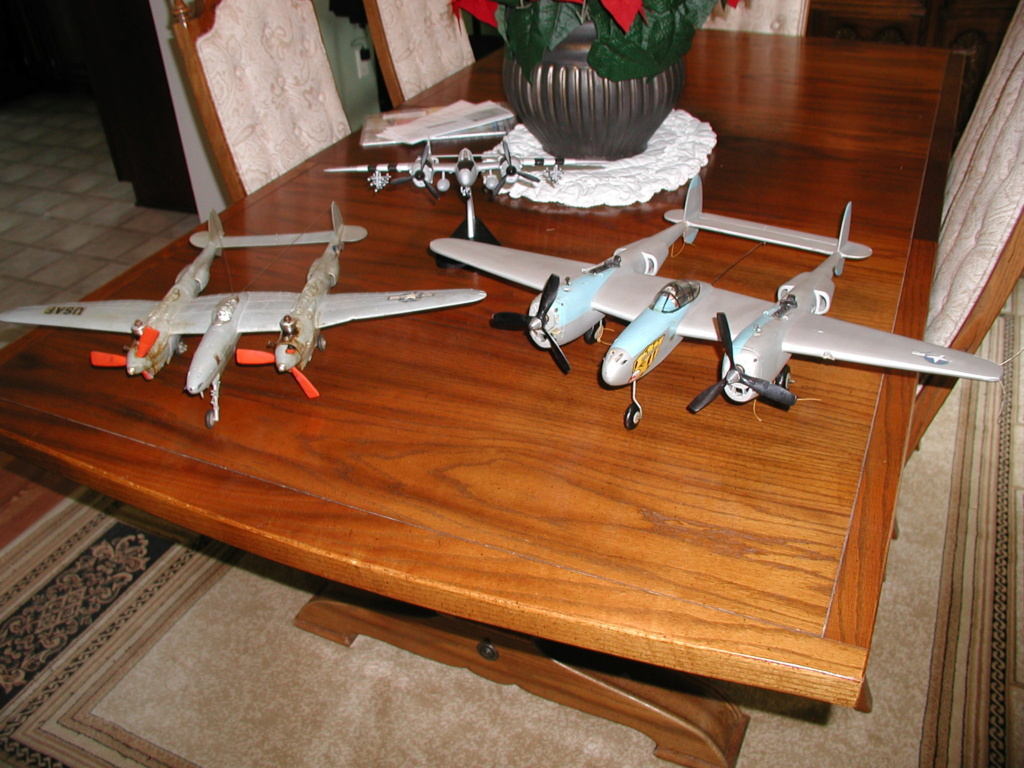
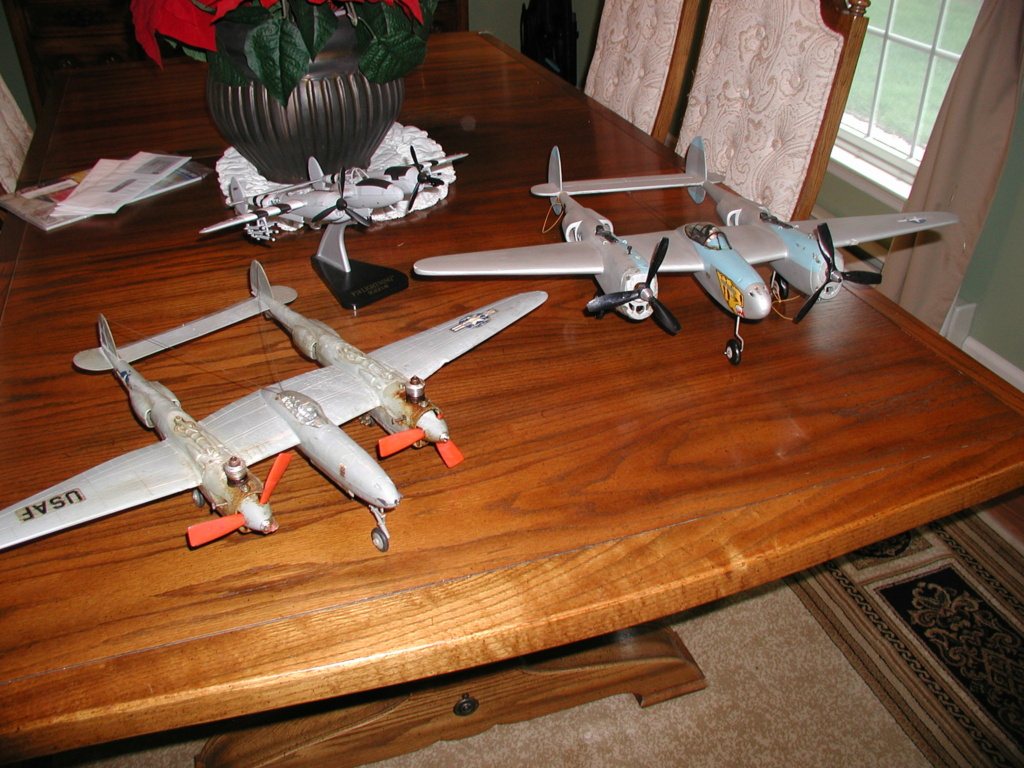

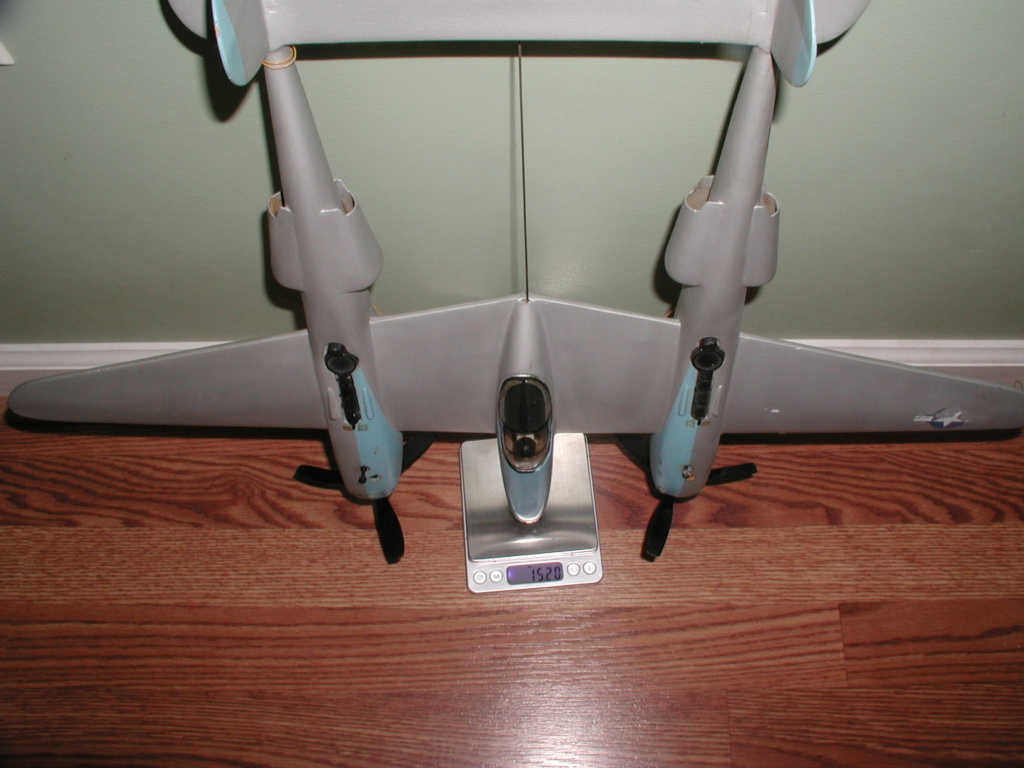
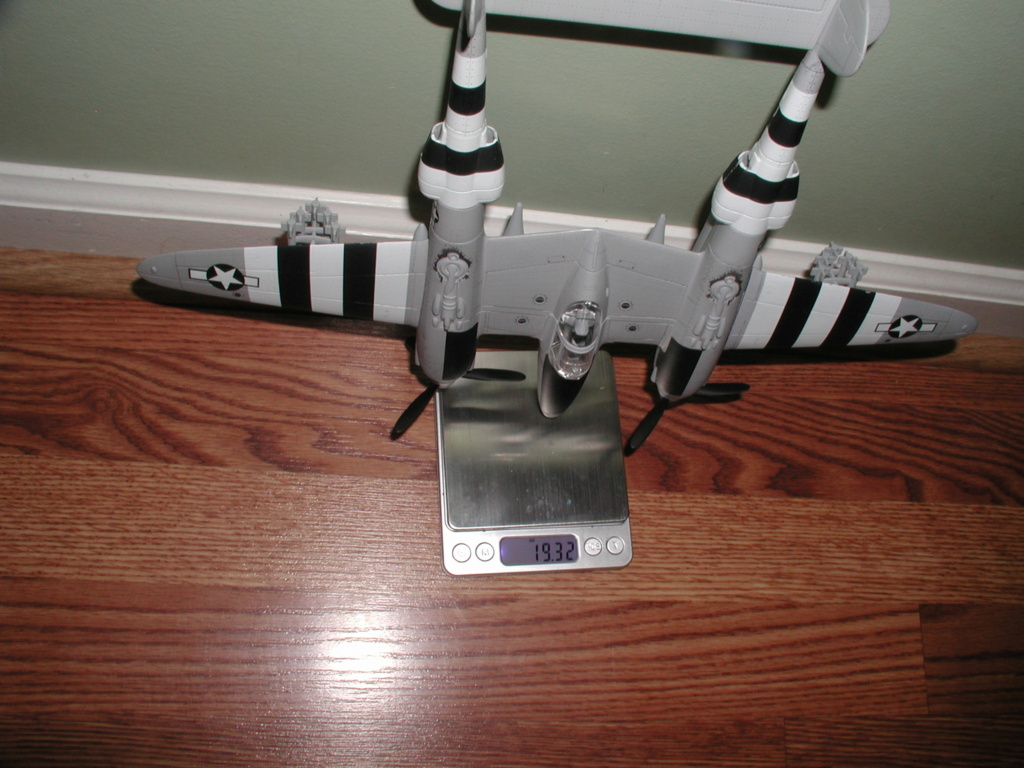
BTW. My issue of Air Classics arrived with the P-38 along with requests for subscription renewals that I gave away in the last year. For those that got them renewals are on you.
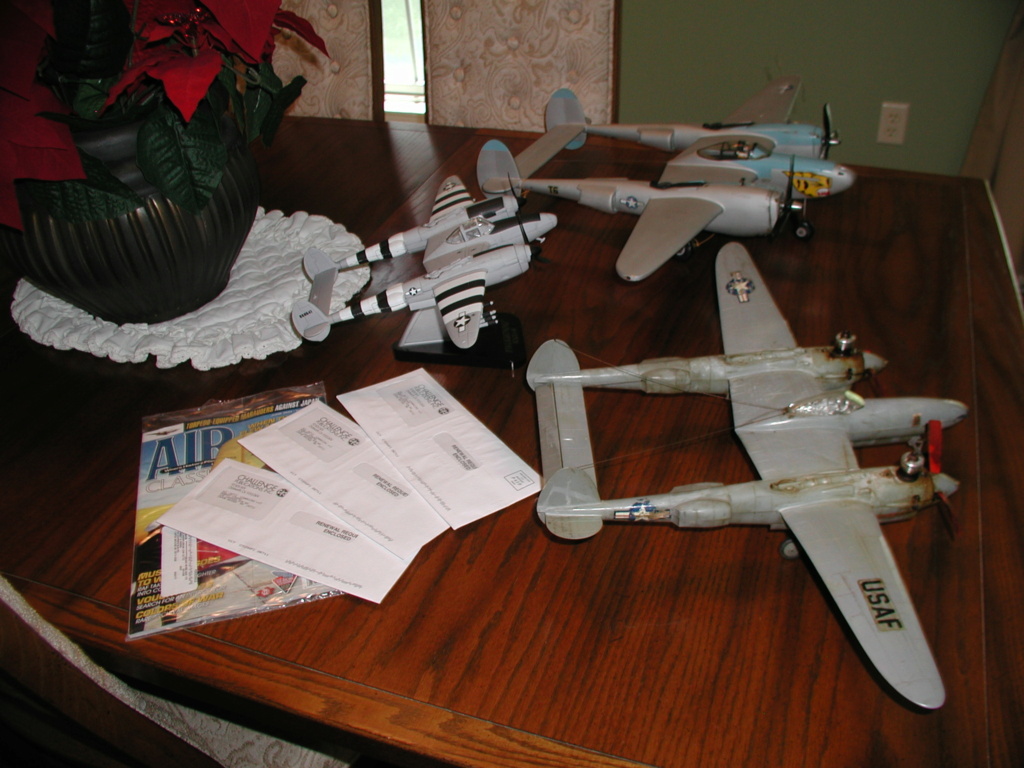
Post Office delivered it today. Little box compared to the unopened Gilbert SkyFlash. Kinda worried, did he take it apart......these don't come apart.

After a mile or so of bubble wrap............somehow I thought it would be bigger.

Eager to check it against my wall hanger but often flown model.

Smaller. "Somehow I thought it would be bigger."





BTW. My issue of Air Classics arrived with the P-38 along with requests for subscription renewals that I gave away in the last year. For those that got them renewals are on you.

Last edited by rsv1cox on Sat May 21, 2022 12:37 pm; edited 1 time in total

rsv1cox- Top Poster




Posts : 11245
Join date : 2014-08-18
Location : West Virginia
 Re: After 84 years, seven months and 15 days the Wen Mac P-38 is here
Re: After 84 years, seven months and 15 days the Wen Mac P-38 is here
WAAAAAAYYYYYYY COOL BOB!!!!! 
















Kim- Top Poster




Posts : 8625
Join date : 2011-09-06
Location : South East Missouri
 Re: After 84 years, seven months and 15 days the Wen Mac P-38 is here
Re: After 84 years, seven months and 15 days the Wen Mac P-38 is here
Waiting for you to work your magic!! Lot'sa pics please.
 Re: After 84 years, seven months and 15 days the Wen Mac P-38 is here
Re: After 84 years, seven months and 15 days the Wen Mac P-38 is here
Duplicate post - deleted. Sorry folks.
 Re: After 84 years, seven months and 15 days the Wen Mac P-38 is here
Re: After 84 years, seven months and 15 days the Wen Mac P-38 is here
I took some size comparison pictures with familiar models to show just how small this W/M P-38 is. It's far truer to scale than I thought it would be. It's amazing that it flew at all with that wing. The Gilbert and the PT-19 were obviously built to fly, not sure about the P-38

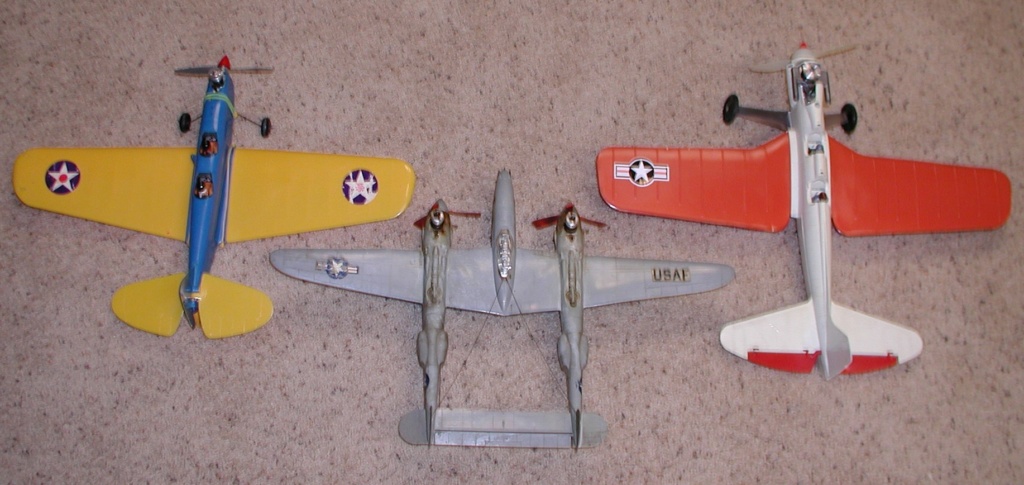
I'm pretty sure that the starter on the left side engine has a problem. The engine is free but I only get about 10 degrees of motion on either side of center before it stops.
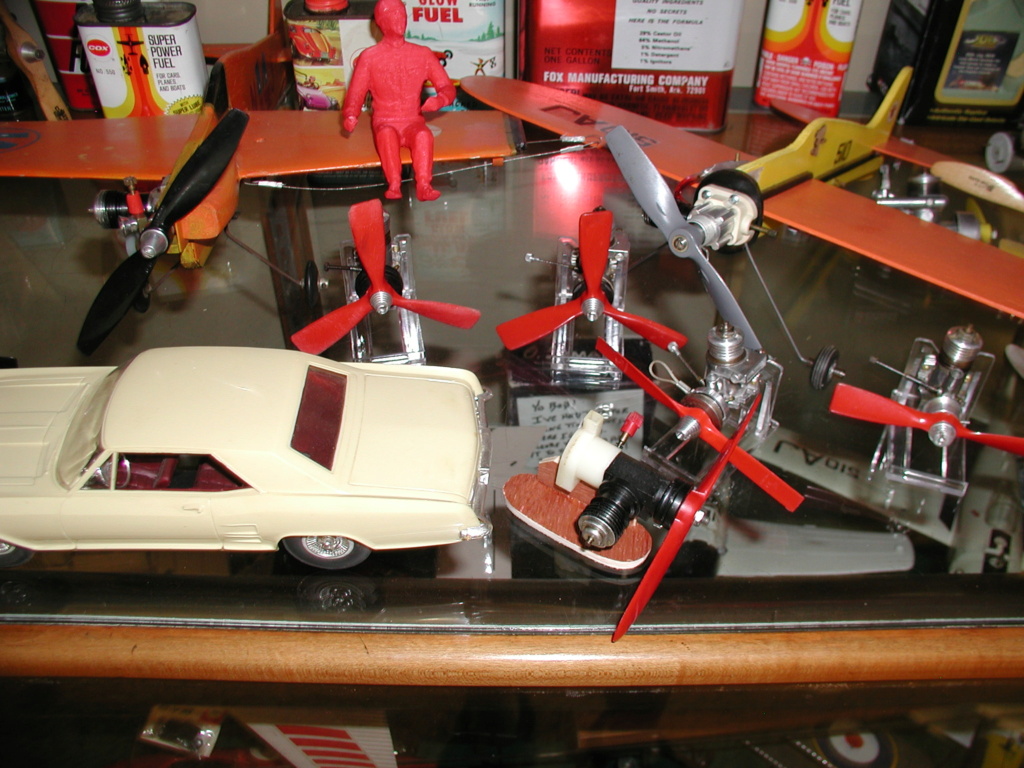
Taking it apart is worrying me, I'm wary of this thing. I know the problems lurking inside all too well. I have spare engines but installing them requires complete disassembly and I know the fuel feed nipples on the tanks are probably separated. The radio antenna wires are nice and taunt, I would probably screw them up. I'm backed into a corner, and don't know if I can find a way out. Thinking.


I'm pretty sure that the starter on the left side engine has a problem. The engine is free but I only get about 10 degrees of motion on either side of center before it stops.

Taking it apart is worrying me, I'm wary of this thing. I know the problems lurking inside all too well. I have spare engines but installing them requires complete disassembly and I know the fuel feed nipples on the tanks are probably separated. The radio antenna wires are nice and taunt, I would probably screw them up. I'm backed into a corner, and don't know if I can find a way out. Thinking.

rsv1cox- Top Poster




Posts : 11245
Join date : 2014-08-18
Location : West Virginia
 Re: After 84 years, seven months and 15 days the Wen Mac P-38 is here
Re: After 84 years, seven months and 15 days the Wen Mac P-38 is here
Bob, from your other photos, it seemed larger, or is this one not the most recent one you "sniped"? 
Fly it does I imagine, but would be a fast flier with high wing loading, more for the thrill of flying multi engine than stunting.
Also because it flies faster, don't know how well they stood up to landing, imagine a number of broken landing gear.
Regarding do now or later, you certainly have enough other projects that to take a break for other easier skirmishes with definitive success stories may be in order, been there done that.
Fly it does I imagine, but would be a fast flier with high wing loading, more for the thrill of flying multi engine than stunting.
Also because it flies faster, don't know how well they stood up to landing, imagine a number of broken landing gear.
Regarding do now or later, you certainly have enough other projects that to take a break for other easier skirmishes with definitive success stories may be in order, been there done that.


GallopingGhostler- Top Poster


Posts : 5721
Join date : 2013-07-13
Age : 70
Location : Clovis NM or NFL KC Chiefs
 Re: After 84 years, seven months and 15 days the Wen Mac P-38 is here
Re: After 84 years, seven months and 15 days the Wen Mac P-38 is here
No, that's it George, one model only.
"Fragile" would be an understatement. I tried to pick it up by the wing tips to find the CG and it just bent in the middle without leaving the table. The landing gear too, it's a wonder that it survived, but the landing gear is perfect. Flyer must have dumped it in the tall grass or got lucky.
The radio antenna looks cool, but I can't find any pictures of it showing, just one which may be an artist conception.


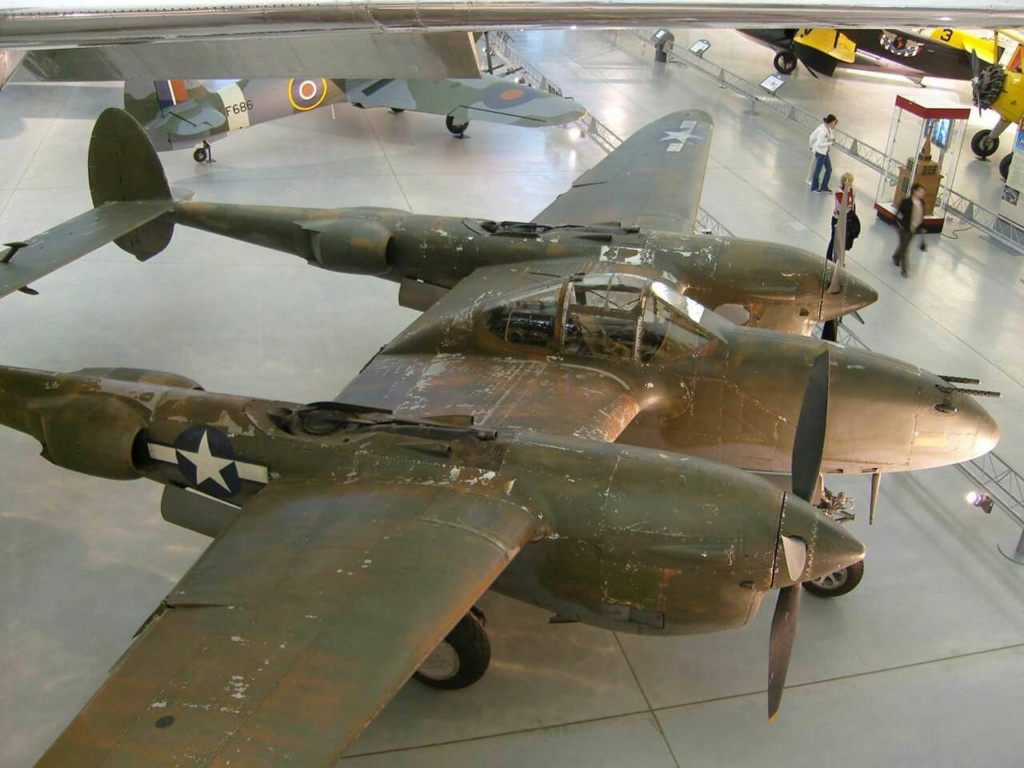
"Fragile" would be an understatement. I tried to pick it up by the wing tips to find the CG and it just bent in the middle without leaving the table. The landing gear too, it's a wonder that it survived, but the landing gear is perfect. Flyer must have dumped it in the tall grass or got lucky.
The radio antenna looks cool, but I can't find any pictures of it showing, just one which may be an artist conception.




rsv1cox- Top Poster




Posts : 11245
Join date : 2014-08-18
Location : West Virginia
 Re: After 84 years, seven months and 15 days the Wen Mac P-38 is here
Re: After 84 years, seven months and 15 days the Wen Mac P-38 is here
Thanks for clarifying, Bob, photo angles using wide angle camera setup (normal for digital camera and cellphone) tends to stretch things. Also interesting, probably need to balance just under the wing near fuselage like we do with radio control.
During WW2, they used lower frequencies for radio and navigation in the kilohertz and lower megahertz range. These required a more lengthy antenna, for greater long range efficiency.
They even carried a telegraph key for Morse code (ancient day texting) because CW (carrier wave) was most efficient for clear, intelligible long distance communication.
Pilots had to be a decent radioman.
To meet modern radio elements, antennas are now more compact, dispensing with the long wire antenna required by much lower frequencies.
That is probably why you don't see these long wire antennas any more.
During WW2, they used lower frequencies for radio and navigation in the kilohertz and lower megahertz range. These required a more lengthy antenna, for greater long range efficiency.
They even carried a telegraph key for Morse code (ancient day texting) because CW (carrier wave) was most efficient for clear, intelligible long distance communication.
Pilots had to be a decent radioman.
To meet modern radio elements, antennas are now more compact, dispensing with the long wire antenna required by much lower frequencies.
That is probably why you don't see these long wire antennas any more.

GallopingGhostler- Top Poster


Posts : 5721
Join date : 2013-07-13
Age : 70
Location : Clovis NM or NFL KC Chiefs
 Re: After 84 years, seven months and 15 days the Wen Mac P-38 is here
Re: After 84 years, seven months and 15 days the Wen Mac P-38 is here
rsv1cox wrote:
The radio antenna looks cool, but I can't find any pictures of it showing, just one which may be an artist conception.
I think you're dead on here -- the only wire antennas I've seen were in paintings or models. The VHF antenna mounted on the front bottom of the central pod seems to be the standard location.
 Re: After 84 years, seven months and 15 days the Wen Mac P-38 is here
Re: After 84 years, seven months and 15 days the Wen Mac P-38 is here
Only radios back then (1940's) using VHF & UHF were Radars, which basically were experimental, IMO. 
Radio communications was all tube (valve), transistors were experimental.

Radio communications was all tube (valve), transistors were experimental.

GallopingGhostler- Top Poster


Posts : 5721
Join date : 2013-07-13
Age : 70
Location : Clovis NM or NFL KC Chiefs
 Re: After 84 years, seven months and 15 days the Wen Mac P-38 is here
Re: After 84 years, seven months and 15 days the Wen Mac P-38 is here
Actually, the SCR-522 radio used in both the P-51 and P-38, especially in the ETO, was classified as VHF and utilized the blade style antenna.
 Re: After 84 years, seven months and 15 days the Wen Mac P-38 is here
Re: After 84 years, seven months and 15 days the Wen Mac P-38 is here
i've been in love with the Lightnings as long as I can remember, that Wen Mac is a beauty.
One of the high spots in my life was 1999 at the San Marcos, Texas CAF Fly-in, where I got to meet Lefty Gardner.
We were walking around the pits, and my buddy's kid Zack was about 7 at the time. The crew did a quick start up then stop on White Lightnin, we were a long way behind it, but Zack yells out at the top of his lungs - "Uncle Charles! They runnin RACE GAS!"
the crew thought it was hilarious, and waved for us to come over
"How do you know what race gas smells like young man"
"well, my dad and my uncle Charles here, they roadrace motorcycles, and that's race gas and castor oil, I'd bet ya a coke"
Zack got to sit in the cockpit, and we had the chance to chat with a living legend for 10 or 15 minutes. I told him I'd been in love with the Lightnin and the B-17, my favorite warbirds. He told me he was partial to well constructed blondes (my buddy's wife! )
)
a really good human, who put on an awesome show. I hear Red Bull bought and restored his plane, its still flying. I like it better in white.
https://vimeo.com/47207890
Cant wait to see how your resto turns out.
One of the high spots in my life was 1999 at the San Marcos, Texas CAF Fly-in, where I got to meet Lefty Gardner.
We were walking around the pits, and my buddy's kid Zack was about 7 at the time. The crew did a quick start up then stop on White Lightnin, we were a long way behind it, but Zack yells out at the top of his lungs - "Uncle Charles! They runnin RACE GAS!"
the crew thought it was hilarious, and waved for us to come over
"How do you know what race gas smells like young man"
"well, my dad and my uncle Charles here, they roadrace motorcycles, and that's race gas and castor oil, I'd bet ya a coke"
Zack got to sit in the cockpit, and we had the chance to chat with a living legend for 10 or 15 minutes. I told him I'd been in love with the Lightnin and the B-17, my favorite warbirds. He told me he was partial to well constructed blondes (my buddy's wife!
a really good human, who put on an awesome show. I hear Red Bull bought and restored his plane, its still flying. I like it better in white.
https://vimeo.com/47207890
Cant wait to see how your resto turns out.
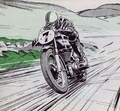
cstatman- Platinum Member



Posts : 568
Join date : 2021-02-17
Age : 60
Location : San Jose, CA
 Re: After 84 years, seven months and 15 days the Wen Mac P-38 is here
Re: After 84 years, seven months and 15 days the Wen Mac P-38 is here
You are correct. I was thinking of the start of war. Apparently the SCR-522, the British equivalent was in use in 1943, discovered to be the same frequency as the German Freya Radar system.andrew wrote:Actually, the SCR-522 radio used in both the P-51 and P-38, especially in the ETO, was classified as VHF and utilized the blade style antenna.
See http://vc.airvectors.net/ttwiz_08.html
The SCR-522 operated on 100 to 156 MHz with transmitter output of 8 to 9 Watts (I am thinking "input" may be incorrect because another site mentions a substitute radio system AN/ARC-3 VHF Radio Set for Aircraft (from pilot's manual) has a transmitter output of 8 Watts. Another mentioned a range of 180 miles at altitude. See:
Radio Research Paper: Ship's Radio Equipment - 1943 (SCR-522 description is about half way down.)
I could find nothing of its initial use, but then communications equipment of this nature was considered to be restricted information. Prior to, long wave, medium wave and short wave were in use. There are sites mentioning WW2 radio jamming techniques, interference, etc., which apparently was the modus operandi for going to UHF. Dec. 7, 1941 attack on Pearl Harbor kicked the US into a wartime economy, having to update a military used to prewar equipment.
There is enough info on the history of the P-38 and the communications equipment used, that would be best expressed as a separate topic. I also found that the SCR-522 used as one antenna an AN-74, which on the bombers had cable aerial strung from fuselage to tail, other end forward in sort of a di-pole.
But, getting back to Bob's question on radio antennas and aerials, photos released from WW2 being absent, my guess is because of the classified nature of radio communications and type of aerial could indicate to the enemy the type of communication equipment on board, perhaps those photos could have been retouched to eliminate them. Also, in order to communicate with British aircraft, the SCR-522-A ("A" means aircraft version?) was a copy of the British TR 1133 VHF set revised to be manufactured with American tooling/parts. It took some time to ramp up training and war production. Prior, I gather that much of the equipment P-38 included was long wave, medium wave and shortwave, where longer aerials were appropriate.
506th Fighter Group - VLR History
VII Fighter Command operations from Iwo Jima, April-August 1945
Major John A. Russ
AIR POWER HISTORY, Volume 48, number 3, Fall 2001
About half way down, makes reference to pre-1945 P-51 Mustangs being equipped with long wave, medium wave and shortwave frequency radio equipment, 1945 and after with the SCR-522. Makes for an interesting read.
- UNCLE DOG & BROTHER AGATE ON IWO JIMA, click here to view content:
- By Mark Starin K1RMC RMC USNR (Ret.)
P-51 Equipped With Uncle Dog/Brother Agate Antennas
Introduction
The story of Uncle Dog and Brother Agate on Iwo Jima is a relatively unknown aspect of the US Army Air Force operations on the island. It involved the work of the 302nd Fighter Control Squadron and one of WW2’s most famous aircraft radios – the SCR-522 – as integral part of the system.
One of the earliest Iwo Jima stories I remember my father (My Starin) telling me was how he made it back alone from Japan using something he called “Brother Agate”. He described it as a VHF (Very High Frequency) homing beacon which allowed him to navigate safely back to the island. The system was patterned after the low frequency A – N systems then commonly used in the United States and adapted for VHF operation. This was the navigation system operated by the 302nd FCS on Mount Suribachi.Typical WW2 P-51 Avionics
Let’s begin with the typical avionics package carried in most P-51’s. I say most because installations can and did vary depending upon the requirements of the theater where the Mustangs were flown.
Here is a diagram from the P-51 service manual depicting the typical avionics package for the P-51A through P-51C aircraft (note that the Uncle Dog equipment is not included):
The equipment includes the SCR-695 which was a multiband airborne transponder which allowed the plane to be identified on friendly radars. Also included is the SCR-522 four channel VHF radio set which was used for air-to-air and air-to-ground communications (plus navigation in the 506th P-51D’s). Not shown is the BC-453/R-23 medium frequency (MF) direction finding (DF) receiver which was installed on many pre-1945 P-51’s.Early P-51 DF Receiver System
The early P-51’s (A through C model plus early D’s) used the standard BC-453/R-23 Command Receiver which could receive continuous wave (CW) or modulated continuous wave (MCW) in the 190 – 550 KHz band. The R-23 was a compact six tube receiver and is shown below:
The antenna was typically either a wire antenna which ran from the cockpit back to the vertical stabilizer (BC-453) or a hand rotatable loop (R-23) which could be mounted in several locations on the fuselage (see 82nd Fighter Group P-51H photo). Although beacons in the MF band had a reliable frequency range of up to 50 miles, there were several problems with this system:
o Noise – static crashes made listening for the beacons very difficult, especially in the summer months
o Bidirectional signals – it was possible to receive MF beacon signals on a primary bearing and a reciprocal bearing (180 degrees opposite the primary) which could lead to the pilot missing an airfield, running out of fuel, or worse
An example of how easy it was to follow a reciprocal instead of the primary bearing is shown in the case of the B-24D “Lady Be Good” in 1943. The navigator, not being sure of his location and thinking he was still over the Mediterranean Sea instead of land, followed the reciprocal bearing past the airfield at Soluch, Libya into the Libyan Desert where the plane crashed after the crew bailed out. The plane and the remains of the crew were not located until 1959.
Anyway, not to bore anyone, there's enough info that it would be best as a separate thread. But, if the VHF antenna system was a simple blade, how do you explain:
https://aeroantique.com/products/antenna-mast-vhf-type-an-74?variant=46426459978
The hole in the top of the AN-74 antenna used with the SCR-522 system and B-17 diagrams showing long wires extending forward of location along fuselage top and from mast to tail?

AN-74 Antenna Mast, notice hole at tip for long wire antenna.

Long wire routing for AN-74 Antenna mast.
Location of SCR-522 system:
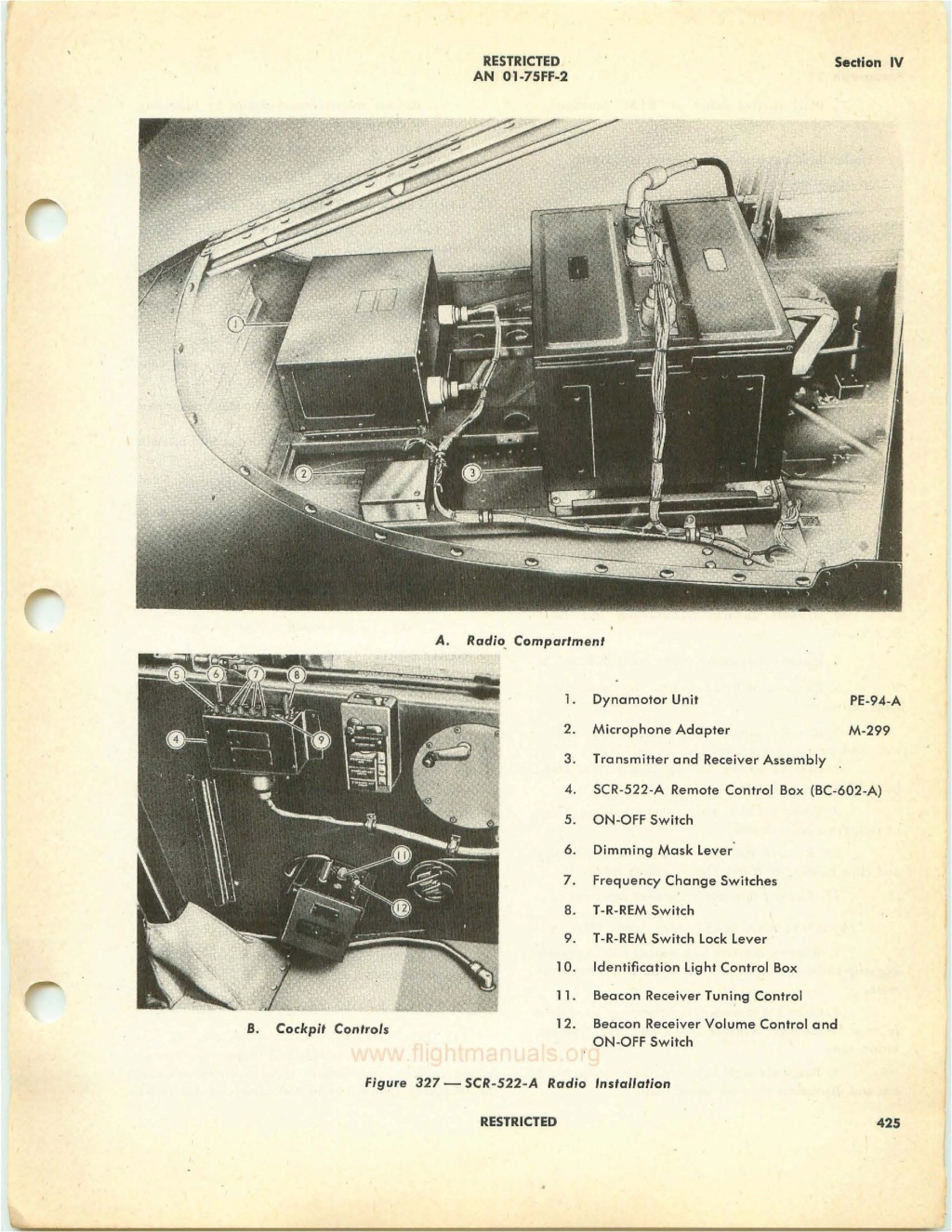
Radio Manual AN 01-75-FF-2, Figure 327 - SCR-522-A Radio Installation
From https://ww2aircraft.net/forum/threads/p-38-radio-installation.56171/ , photo references source as www.flightmanuals.org
https://radionerds.com/index.php/SCR-522 :
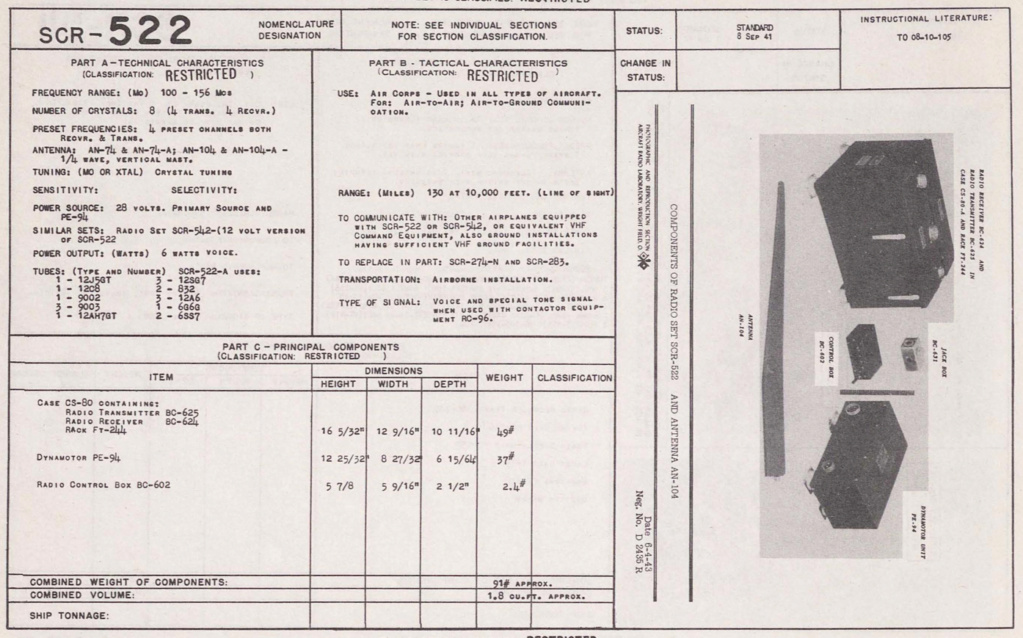
SCR-522 Datasheet from radionerds.
Fighter Aircraft Radio. (ground unit is SCR-624), components: (1) BC-625 transmitter, (2) BC-624 Receiver, (3) FT-244 container, (4) PE-94 Dyno., (5) BC-602 control box, (6) AN-74 antenna mast, (7) AN-104 antenna, [8 - RA-62 for ground stations].
The datasheet is dated June 4, 1943, so figuring production of the radio probably occurred after and the dates in other websites corresponding to 1944 and 1945 may indicate implementation in fighter models. And, regarding lower power of these transmitters back then of say 9 Watts, (shoot!
 my Ace R/C Pulse Commander was what? 0.5 Watts?
my Ace R/C Pulse Commander was what? 0.5 Watts? So, at the start of the War, US had a lot of catching up to do, I gather, radio systems included, which were being implemented about 2 to 4 years after Pearl Harbor attack on Dec. 7, 1941, depending on theater and model / roll of aircraft.


GallopingGhostler- Top Poster


Posts : 5721
Join date : 2013-07-13
Age : 70
Location : Clovis NM or NFL KC Chiefs
 Re: After 84 years, seven months and 15 days the Wen Mac P-38 is here
Re: After 84 years, seven months and 15 days the Wen Mac P-38 is here
THAT was a great research post!!
Perhaps one of the Admins could add a topic area where technical discussions such as yours could reside -- with Bob's restorations having scale implications and many here with mechanical and electronic expertise, I think it could be a viable area, for those so inclined.
Perhaps one of the Admins could add a topic area where technical discussions such as yours could reside -- with Bob's restorations having scale implications and many here with mechanical and electronic expertise, I think it could be a viable area, for those so inclined.
 Re: After 84 years, seven months and 15 days the Wen Mac P-38 is here
Re: After 84 years, seven months and 15 days the Wen Mac P-38 is here
andrew wrote:THAT was a great research post!!
Perhaps one of the Admins could add a topic area where technical discussions such as yours could reside -- with Bob's restorations having scale implications and many here with mechanical and electronic expertise, I think it could be a viable area, for those so inclined.
Yes, George, dot's all the i's and crosses all the t's.

rsv1cox- Top Poster




Posts : 11245
Join date : 2014-08-18
Location : West Virginia
 Re: After 84 years, seven months and 15 days the Wen Mac P-38 is here
Re: After 84 years, seven months and 15 days the Wen Mac P-38 is here
Thanks. Now that I think of it, I was doing may be 2 or 3 years ago, a look up on the Norden Bomb Sight used in the various US and Allied bombers. The training videos posted by historic societies on YouTube were fascinating. What they called "precision high altitude bombing" in the 1940's is now what we call, "carpet bombing".  If it took out a couple city blocks just to get that one enemy HQ building, it was considered precision.
If it took out a couple city blocks just to get that one enemy HQ building, it was considered precision. 
The mechanism to deploy the parachuted aircrew is sort of a throwback to Keith Laumer's 1960's book on designing, building and flying model aircraft, where he described retracting landing gear, pendulum control stability for FF aircraft, and other sorts of things as food for thought. Walt Musciano had similar but differing ideas as food for thought, too, how to do carrier arresting hook deployment for "carrier landings", glider pickup system for retrieving his 36" Waco G4C tow line glider by his single engine Vickers Wellesley CL bomber. This helped to spur the imaginations of adolescents back then who read these, then encouraged them to come up with something on their CL or FF aircraft.
I suppose if one really wanted to, they could devise a methodology on their own built CL aircraft, to deploy bail-out triggered by say momentary full down elevator as a release mechanism at the apex of a wing over.
Also of interest, there are two Walt Musciano designs on Outerzone of the P-38 as full fuselage CL, nominal wingspan around 40 inches.
Going back to radio aerials on aircraft, I never bothered to install these to include the masts, because they were so prone to breakage. This includes, CL, FF, and RC aircraft, glider, rubber powered and glow.
One of my favorite toys was a hollow plastic paratrooper with an 8 or 10 inch diameter parasheet (flat, unlike the half parabolic profile of a real parachute) with 6 to 8 strings about a foot long. I'd roll it up, throw it as I as I could go, or with open parachute, drop it from the house roof or in a tree. It would float down slowly. One time, threw it up and it got caught in the eddying turbulence of wind surrounding the house, went up about 40 feet before descending. That was a thrill to watch.
I'd keep it repaired by using Scotch tape to reattach torn lines, until the canopy was thoroughly worn out. (They didn't have plastic grocery store bags then.) In high school, I'd use as replacement Astron (Estes) parachutes for model rockets. (Then, mail order parts from Estes Colorado were reasonably priced.) Later, when I was older, I'd make for kids parachutes out of garbage bags (for larger, say 24" span, 12" out of plastic grocery bags), and the inexpensive plastic toy soldiers.
There's a lot one can do with little or no outlay of money.
The mechanism to deploy the parachuted aircrew is sort of a throwback to Keith Laumer's 1960's book on designing, building and flying model aircraft, where he described retracting landing gear, pendulum control stability for FF aircraft, and other sorts of things as food for thought. Walt Musciano had similar but differing ideas as food for thought, too, how to do carrier arresting hook deployment for "carrier landings", glider pickup system for retrieving his 36" Waco G4C tow line glider by his single engine Vickers Wellesley CL bomber. This helped to spur the imaginations of adolescents back then who read these, then encouraged them to come up with something on their CL or FF aircraft.
I suppose if one really wanted to, they could devise a methodology on their own built CL aircraft, to deploy bail-out triggered by say momentary full down elevator as a release mechanism at the apex of a wing over.
Also of interest, there are two Walt Musciano designs on Outerzone of the P-38 as full fuselage CL, nominal wingspan around 40 inches.
Going back to radio aerials on aircraft, I never bothered to install these to include the masts, because they were so prone to breakage. This includes, CL, FF, and RC aircraft, glider, rubber powered and glow.
One of my favorite toys was a hollow plastic paratrooper with an 8 or 10 inch diameter parasheet (flat, unlike the half parabolic profile of a real parachute) with 6 to 8 strings about a foot long. I'd roll it up, throw it as I as I could go, or with open parachute, drop it from the house roof or in a tree. It would float down slowly. One time, threw it up and it got caught in the eddying turbulence of wind surrounding the house, went up about 40 feet before descending. That was a thrill to watch.
I'd keep it repaired by using Scotch tape to reattach torn lines, until the canopy was thoroughly worn out. (They didn't have plastic grocery store bags then.) In high school, I'd use as replacement Astron (Estes) parachutes for model rockets. (Then, mail order parts from Estes Colorado were reasonably priced.) Later, when I was older, I'd make for kids parachutes out of garbage bags (for larger, say 24" span, 12" out of plastic grocery bags), and the inexpensive plastic toy soldiers.
There's a lot one can do with little or no outlay of money.


GallopingGhostler- Top Poster


Posts : 5721
Join date : 2013-07-13
Age : 70
Location : Clovis NM or NFL KC Chiefs

Levent Suberk- Diamond Member

- Posts : 2265
Join date : 2017-12-24
Location : Türkiye

Levent Suberk- Diamond Member

- Posts : 2265
Join date : 2017-12-24
Location : Türkiye

Levent Suberk- Diamond Member

- Posts : 2265
Join date : 2017-12-24
Location : Türkiye
 Re: After 84 years, seven months and 15 days the Wen Mac P-38 is here
Re: After 84 years, seven months and 15 days the Wen Mac P-38 is here
Levent Suberk wrote:Sorry for hijacking thread
Hijackers welcome Levent. Enjoyed your video.
Bob

rsv1cox- Top Poster




Posts : 11245
Join date : 2014-08-18
Location : West Virginia
 Re: After 84 years, seven months and 15 days the Wen Mac P-38 is here
Re: After 84 years, seven months and 15 days the Wen Mac P-38 is here
Yes, yes, yes!Levent Suberk wrote:Sorry for hijacking thread
 )
)
Who really hijacked this thread with history on WW2 radios? And, who encouraged deviation by posting about toy Army man parachute experiences?



Seriously, your post IMO is a related topic, because as a part of the build, because the repair thread includes parachute bailout system on a historic, nostalgic but rare to find these days Ready-to-Fly. Friendship includes discussions, which also brings up related topics of interest. If we did not include these, then IMO, our forum would appear more robotic.


GallopingGhostler- Top Poster


Posts : 5721
Join date : 2013-07-13
Age : 70
Location : Clovis NM or NFL KC Chiefs
 Similar topics
Similar topics» 21 years, 4 months, 11 days
» Bob, you make me miss my Mossie. My phone pictures app just reminded me I totalled it two years ago yesterday. This HAS been a fast two years
» Some Days are Diamonds...Some Days are Stone...
» Ordered a 1/2A Skyray kit
» Found after 7 months
» Bob, you make me miss my Mossie. My phone pictures app just reminded me I totalled it two years ago yesterday. This HAS been a fast two years
» Some Days are Diamonds...Some Days are Stone...
» Ordered a 1/2A Skyray kit
» Found after 7 months
Page 1 of 1
Permissions in this forum:
You cannot reply to topics in this forum

 Rules
Rules







